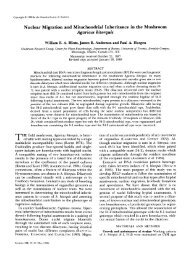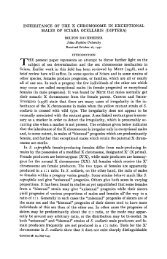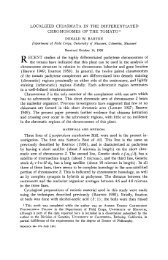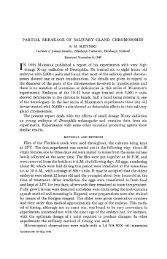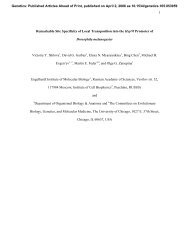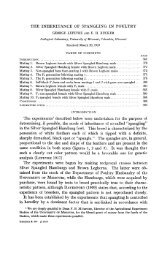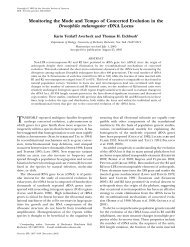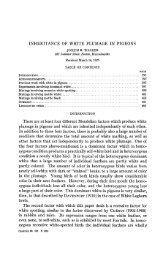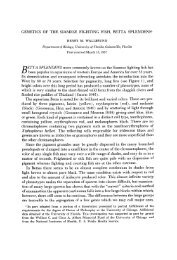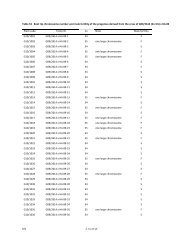abstracts of papers presented at the 1962 meetings - Genetics
abstracts of papers presented at the 1962 meetings - Genetics
abstracts of papers presented at the 1962 meetings - Genetics
Create successful ePaper yourself
Turn your PDF publications into a flip-book with our unique Google optimized e-Paper software.
996 ABSTRACTS<br />
observed in p-galactosidase production. This characteristic lag was not observed in a constitutive<br />
mutant <strong>of</strong> E. coli 58-161. Therefore, it seems th<strong>at</strong>, in E. coli 58-161, a repressor <strong>of</strong> ,&galactosidase<br />
accumul<strong>at</strong>ed concommitantly with RNA during methionine starv<strong>at</strong>ion. This repression is how-<br />
ever, not reversible by an inducer <strong>of</strong> P-galactosidase.<br />
YOON, C. H., and S. LIZIO, Boston College, Chestnut Hill, Mass.: Evidence <strong>of</strong> incorpor<strong>at</strong>ion <strong>of</strong><br />
tagged DNA extracted from thymus glands into germ cells <strong>of</strong> recipient mice.-DNA <strong>of</strong> <strong>the</strong><br />
thymus glands <strong>of</strong> mice was tagged with P32 and was extracted. This extracted DNA was <strong>the</strong>n<br />
injected into gonads <strong>of</strong> recipient mice. Evidence th<strong>at</strong> indic<strong>at</strong>es th<strong>at</strong> this tagged DNA was incor-<br />
por<strong>at</strong>ed into DNA <strong>of</strong> germ cells <strong>of</strong> recipient mice was obtained.<br />
YOSHIKAWA, HIROSHI, and NOEKIRU SUEOKA, University <strong>of</strong> Illinois, Urbana, Ill.: Mechanism<br />
<strong>of</strong> chromosome replic<strong>at</strong>ion in Bacillus subti1is.-A series <strong>of</strong> experiments were designed to test<br />
two major altern<strong>at</strong>ive models <strong>of</strong> chromosome replic<strong>at</strong>ion by using genetic transform<strong>at</strong>ion system<br />
<strong>of</strong> B. subtilis. Model A (random-in-time replic<strong>at</strong>ion) : replic<strong>at</strong>ion <strong>of</strong> DNA in <strong>the</strong> chromosome<br />
occurs simultaneously in <strong>the</strong> whole region <strong>of</strong> <strong>the</strong> chromosome without any oriented sequence<br />
along <strong>the</strong> chromosome. Model B (oriented replic<strong>at</strong>ion) : replic<strong>at</strong>ion <strong>of</strong> DNA starts from one or<br />
both ends <strong>of</strong> <strong>the</strong> chromosome and proceeds orderly. The principle <strong>of</strong> our experiment is to culture<br />
a wild type strain in a heavy meclium containing deuterium and nitrogen-15, and transfer to a<br />
light medium (H20, NI4). Cell samples are taken <strong>at</strong> 0, %, K and 1 gener<strong>at</strong>ions after <strong>the</strong> transfer.<br />
DNA from each sample is centrifuged in CsCl solution, and heavy and hybrid DNA molecules<br />
are separ<strong>at</strong>ed by collecting single drops from <strong>the</strong> bottom <strong>of</strong> <strong>the</strong> centrifuge tube. Measuring <strong>the</strong><br />
specific transforming activity (STA) <strong>of</strong> 12 different auxotrophic markers in heavy and hybrid<br />
DNA molecules, it is predicted th<strong>at</strong> if <strong>the</strong> random-in-time replic<strong>at</strong>ion model is right, <strong>the</strong> STA's<br />
<strong>of</strong> both heavy and hybrid DNA should he similar, while in <strong>the</strong> oriented replic<strong>at</strong>ion model <strong>the</strong>re<br />
should be difference in STA's between heavy and hybrid DNA. Moreover, in <strong>the</strong> l<strong>at</strong>ter model,<br />
each marker should give a distinct r<strong>at</strong>io <strong>of</strong> STA's in <strong>the</strong> two DNA, depending on <strong>the</strong> loc<strong>at</strong>ion <strong>of</strong><br />
<strong>the</strong> marker in <strong>the</strong> chromosome. The experimental results so far obtained are consistent with <strong>the</strong><br />
oriented replic<strong>at</strong>ion model. Results <strong>of</strong> fur<strong>the</strong>r experiments on this line will be <strong>presented</strong>. (This<br />
work is supported by N<strong>at</strong>ional Science Found<strong>at</strong>ion grants G-15080 and G-18745.)<br />
ZALOKAR, M., University <strong>of</strong> California, La Jolla, Calif.: The role <strong>of</strong> nucleolus in <strong>the</strong> production<br />
<strong>of</strong> ribonucleic acid.-The incorpor<strong>at</strong>ion <strong>of</strong> H3-uridine into RNA <strong>of</strong> oocyte nuclei <strong>of</strong> Bl<strong>at</strong>ella<br />
germanica was studied by autoradiography. When oocytes were incub<strong>at</strong>ed in H3-uridine for<br />
four to 16 minutes, <strong>the</strong> newly formed, labeled RNA appeared in both nucleoli and chromosomes.<br />
Nucleolar RNA was first observed in several spots <strong>at</strong> <strong>the</strong> periphery <strong>of</strong> <strong>the</strong> nucleolus. After one<br />
hour or longer incub<strong>at</strong>ion <strong>the</strong> nucleolus became uniformly labeled. These observ<strong>at</strong>ions indic<strong>at</strong>e<br />
th<strong>at</strong> nucleolar RNA was produced <strong>at</strong> <strong>the</strong> periphery <strong>of</strong> <strong>the</strong> nucleolus, where <strong>the</strong> presence <strong>of</strong> DNA<br />
could be demonstr<strong>at</strong>ed. It is probably not <strong>the</strong> nucleolus itself which pnoduces nucleolar RNA,<br />
hut this DNA belonging to <strong>the</strong> chromosomal regions adjacent to <strong>the</strong> nucleolus. Experiments<br />
with Actinomycin D showed th<strong>at</strong> this DNA is functionally different from DNA in <strong>the</strong> rest <strong>of</strong><br />
chromosomes. When oocytes were incub<strong>at</strong>ed in H3-uridine in <strong>the</strong> presence <strong>of</strong> 2 pg/ml <strong>of</strong> Actinomycin<br />
D, nucleoli remained unlabeled, while chromosomes became labeled nearly as strongly<br />
as in <strong>the</strong> absence <strong>of</strong> <strong>the</strong> drug. At higher concentr<strong>at</strong>ions (IO pg/ml) Actinomycin D inhibited<br />
both nucleolar and chromosomal RNA production. In conclusion it appears th<strong>at</strong> <strong>the</strong> nucleoli serve<br />
as intermedi<strong>at</strong>e storage or processing place for a certain kind <strong>of</strong> RNA, produced by particular<br />
regions <strong>of</strong> chromosomes. The problem <strong>of</strong> transfer <strong>of</strong> chromosomal and nucleolar RNA into <strong>the</strong><br />
cytoplasm is now being studied by inhibiting new RNA form<strong>at</strong>ion with Actinomycin D.<br />
ZAMENHOF, S., and ROSALIE DE GIOVANNI-DONNELLY, Columbia University, New York, N.Y.:<br />
He<strong>at</strong>-induced "coupled" mut<strong>at</strong>ions in B. subtilis-Among nine histidine- mutants obtained by<br />
he<strong>at</strong>ing spores <strong>of</strong> <strong>the</strong> originally indole- strain 168 <strong>of</strong> B. subtilis, three have lost or altered this





